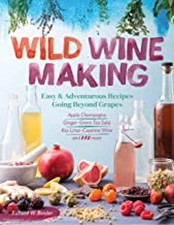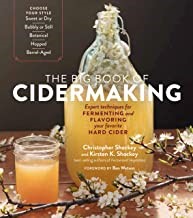As we have some very good wine making books in our collection, we haven’t added new books on the topic for a while as there haven’t been many good ones that have much new to offer. However, in the process of doing research for the eLibrary, I came across some new titles and have added some of these winemaking books to the Club print library. These items are available for check-out via pickup, or by U.S. mail as the club as agreed to pay the postage to get the items to you to further your wine enjoyment and wine making education. I will have more items for you the next few months. You can reach me at gfrouse@gmail.com
 The Complete Guide to Making Your Own Wine at Home, by John Peragine is a good starter book and nicely eases the reader into more and more complex topics. This is readily apparent in the first few chapters as the author discusses water sources, sugars, yeasts, and the minimum of equipment you need to get started. Chapters 3, 4, and 5 cover making wine from kits, juices, and grapes, respectively. Chapter 6 covers 24 different winemaking mistakes and how to fix them. Chapter 7 covers “country wines” or wines made from fruits, vegetable, and herb ingredients. Chapter 8 covers mead, cyser, pyment, and malomels. Chapter 9 is on labeling and organizing your cellar, while Chapter 10 briefly covers starting a home vineyard. The final chapter discusses the pros and cons of Opening Your Own Winery. The book includes some good, but slightly dated appendices. Other books in our collection cover some of these topics in more depth, but this is a good book for the beginning winemaker. 2010 paperback.
The Complete Guide to Making Your Own Wine at Home, by John Peragine is a good starter book and nicely eases the reader into more and more complex topics. This is readily apparent in the first few chapters as the author discusses water sources, sugars, yeasts, and the minimum of equipment you need to get started. Chapters 3, 4, and 5 cover making wine from kits, juices, and grapes, respectively. Chapter 6 covers 24 different winemaking mistakes and how to fix them. Chapter 7 covers “country wines” or wines made from fruits, vegetable, and herb ingredients. Chapter 8 covers mead, cyser, pyment, and malomels. Chapter 9 is on labeling and organizing your cellar, while Chapter 10 briefly covers starting a home vineyard. The final chapter discusses the pros and cons of Opening Your Own Winery. The book includes some good, but slightly dated appendices. Other books in our collection cover some of these topics in more depth, but this is a good book for the beginning winemaker. 2010 paperback.
 Wild Wine Making, by Richard W. Bender. The subtitle of this book, “Easy and Adventurous Recipes Going Beyond Grapes” sums it up well, as you won’t find a more thorough, creative book of recipes. Chapter 1 covers what you need to make these wines, and the author encourages small-batch, one gallon batches with a minimal amount of equipment. Chapter 2 covers the author’s approach to winemaking, calling it “… fairly straightforward and quick process, although it can be messy.” He goes through 10 easy to follow steps; perfect for the inexperienced fruit wine maker. The real fun begins with Chapter 3 as it contains 76 different fruit and vegetable wine recipes. Examples include Apple Champagne, Burgundy Kale, Ozark Pumpkin Sake, and Strawberry Chocolate. Chapter 4 is Flower & Herb Wines and the author describes it as “… you essentially are brewing a strong sweet tea and then adding yeast.” Recipe examples are Cinnamon Basil, Ginger-Green Tea Sake, and Rosemary. Chapter 5 is on Hot Pepper Wines and the author blends in fruits so the wines are drinkable on their own, although they work well for cooking wines. He suggests these are more pre-meal wines served as small one-ounce servings. Recipes include Key Lime-Cayenne and Tomato-Jalapeno. For the really adventurous, Chapter 6 covers Cannabis Wines that include recipes such as Appleweed, Christmas Cannabis and Plum Pot. Chapter 7 covers pairing these wines with foods/cheeses, cooking with these wines, and hosting a tasting or winemaking party. If you’re already a fruit wine maker and want to get some inspiration, I highly recommend reviewing the 145 recipes in this beautifully photographed 2018 paperback.
Wild Wine Making, by Richard W. Bender. The subtitle of this book, “Easy and Adventurous Recipes Going Beyond Grapes” sums it up well, as you won’t find a more thorough, creative book of recipes. Chapter 1 covers what you need to make these wines, and the author encourages small-batch, one gallon batches with a minimal amount of equipment. Chapter 2 covers the author’s approach to winemaking, calling it “… fairly straightforward and quick process, although it can be messy.” He goes through 10 easy to follow steps; perfect for the inexperienced fruit wine maker. The real fun begins with Chapter 3 as it contains 76 different fruit and vegetable wine recipes. Examples include Apple Champagne, Burgundy Kale, Ozark Pumpkin Sake, and Strawberry Chocolate. Chapter 4 is Flower & Herb Wines and the author describes it as “… you essentially are brewing a strong sweet tea and then adding yeast.” Recipe examples are Cinnamon Basil, Ginger-Green Tea Sake, and Rosemary. Chapter 5 is on Hot Pepper Wines and the author blends in fruits so the wines are drinkable on their own, although they work well for cooking wines. He suggests these are more pre-meal wines served as small one-ounce servings. Recipes include Key Lime-Cayenne and Tomato-Jalapeno. For the really adventurous, Chapter 6 covers Cannabis Wines that include recipes such as Appleweed, Christmas Cannabis and Plum Pot. Chapter 7 covers pairing these wines with foods/cheeses, cooking with these wines, and hosting a tasting or winemaking party. If you’re already a fruit wine maker and want to get some inspiration, I highly recommend reviewing the 145 recipes in this beautifully photographed 2018 paperback.
 The Big Book of Cidermaking, by Christopher and Kirsten K. Shockey Ben Watson makes a good point right in the forward “… that cider at its highest and best expression doesn’t use a recipe, but a process.” This sets the tone for this comprehensive book on cider making as the authors later explain why they made this book. They believe we’re in a cider renaissance with many of the old rules are fine, but there’s no reason to limit your creativity and encourage the reader to pursue the style and flavor you like. They encourage the maker to start our simple and small batch and then move up to larger, more complex batches as you gain experience. The book covers various methods of processing apples, blending juices, and has many step-by-step processes with good photographs to show you how to do key steps. There are recipes, but the emphasis is more on the process than the ingredients. They cover wild and cultivated ciders, wild-yeast ciders, infused ciders, as well as iced, wined and spirited ciders. The last chapter does a nice job of suggesting how to taste and judge ciders, and there is a good appendix for troubleshooting your cider problems. If you’re a cider maker, or want to become one, this is a book for you. 2020 paperback.
The Big Book of Cidermaking, by Christopher and Kirsten K. Shockey Ben Watson makes a good point right in the forward “… that cider at its highest and best expression doesn’t use a recipe, but a process.” This sets the tone for this comprehensive book on cider making as the authors later explain why they made this book. They believe we’re in a cider renaissance with many of the old rules are fine, but there’s no reason to limit your creativity and encourage the reader to pursue the style and flavor you like. They encourage the maker to start our simple and small batch and then move up to larger, more complex batches as you gain experience. The book covers various methods of processing apples, blending juices, and has many step-by-step processes with good photographs to show you how to do key steps. There are recipes, but the emphasis is more on the process than the ingredients. They cover wild and cultivated ciders, wild-yeast ciders, infused ciders, as well as iced, wined and spirited ciders. The last chapter does a nice job of suggesting how to taste and judge ciders, and there is a good appendix for troubleshooting your cider problems. If you’re a cider maker, or want to become one, this is a book for you. 2020 paperback.
